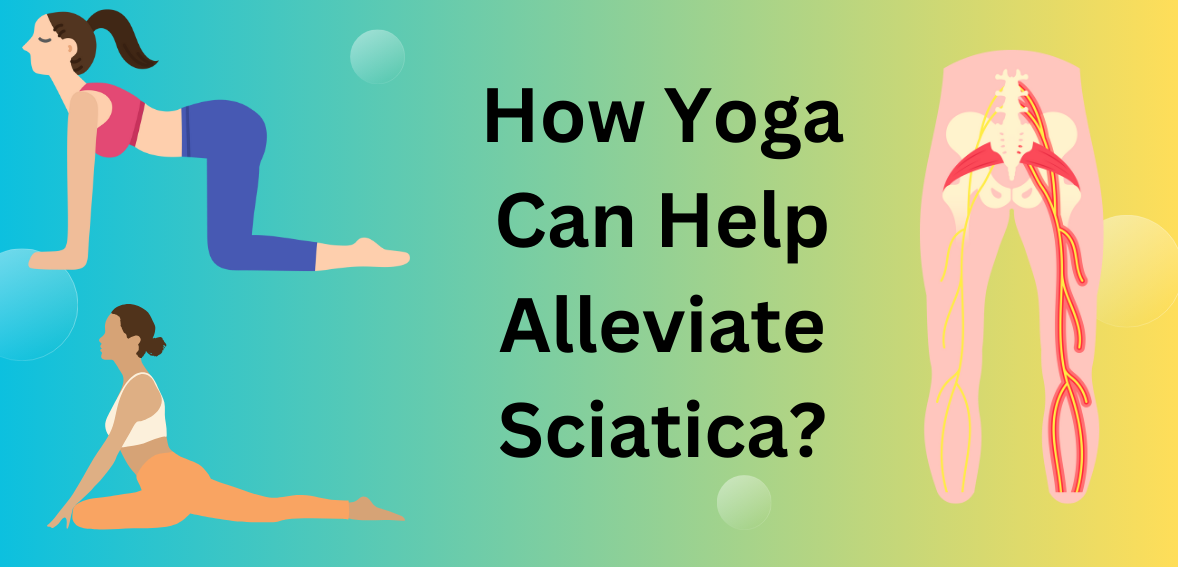Are you tired of living with the constant pain and discomfort caused by sciatica? If so, it’s time to roll out your yoga mat and discover how this ancient practice can alleviate your symptoms. Yoga has long been celebrated for its ability to promote physical and mental well-being, making it a powerful tool in managing conditions like sciatica. In this blog post, we will explore the connection between yoga and sciatica relief, as well as share five essential poses that can help ease your discomfort. So, grab your mat and get ready to find some much-needed relief from sciatic nerve pain!
Understanding Sciatica and its Symptoms
Sciatica is a condition that affects millions of people worldwide, causing pain and discomfort along the sciatic nerve. But what exactly is sciatica? The sciatic nerve is the longest nerve in your body, running from your lower back down through your hips and buttocks, and all the way to your feet. When this nerve becomes irritated or compressed, it can lead to a variety of symptoms.
One of the most common symptoms of sciatica is shooting pain that radiates down one leg. This pain can be intense and debilitating, making it difficult to perform everyday activities. In addition to pain, individuals with sciatica may also experience tingling or numbness in their legs or feet. Some may even have difficulty controlling their muscles or experience weakness in their affected leg.
Sciatica can occur for a variety of reasons, including herniated discs, spinal stenosis (narrowing of the spinal canal), or muscle imbalances. It’s important to note that while yoga can provide relief for many individuals with sciatica, it’s always best to consult with a healthcare professional before starting any new exercise program.
By understanding the nature of sciatica and its associated symptoms, you’ll be better equipped to find targeted solutions for managing your discomfort. So let’s dive into how yoga can help alleviate these pesky symptoms!
How Yoga Can Help Alleviate Sciatica Pain
Yoga has long been praised for its ability to improve flexibility, strength, and overall well-being. But did you know that it can also be a powerful tool in alleviating sciatica pain? Sciatica is a condition characterized by pain radiating along the path of the sciatic nerve, which runs from the lower back down through the hips and buttocks and into each leg. It can be caused by various factors such as herniated discs, spinal stenosis, or even muscle imbalances.
So how exactly can yoga help with sciatica symptoms? One of the main benefits of yoga is its emphasis on stretching and strengthening muscles throughout the body, including those in the lower back and hips. By practicing specific poses that target these areas, you can increase blood flow to affected areas, release tension in tight muscles, and ultimately reduce inflammation and alleviate pain.
Here are five essential yoga poses that can provide relief for sciatica:
Essential Poses for Relieving Sciatica Symptoms
When it comes to finding relief from sciatica symptoms, incorporating yoga into your routine can be incredibly beneficial. Yoga not only helps improve flexibility and strength, but it also promotes relaxation and reduces stress – all of which can alleviate the discomfort caused by sciatica.
Here are five essential poses that target the areas affected by sciatic nerve pain:
1. Downward Facing Dog: This pose stretches the hamstrings, calves, and lower back while also strengthening the core muscles. Start on all fours with your hands shoulder-width apart and lift your hips towards the ceiling, forming an inverted V shape with your body.
2. Pigeon Pose: Pigeon pose is a deep hip opener that targets tightness in the glutes and piriformis muscles – common culprits of sciatic pain. Begin in a high plank position, bring one knee forward towards your chest, then place it behind your wrist with the foot flexed.
3. Cat-Cow Stretch: This gentle flowing movement helps release tension in the spine and stretches out both sides of the body simultaneously. Start on all fours with a neutral spine position, then arch your back up like an angry cat before dropping it down into a swayback cow position.
4. Reclined Hand-to-Big-Toe Pose: Lie flat on your back with legs extended straight up toward the ceiling using either a strap or handhold onto big toes keeping elbows bent out to sides squeeze thigh muscles toward bones as you lengthen through heels extending feet up
5. Seated Spinal Twist : Sitting tall extend right leg out draw left foot to inside of right thigh bend right knee wrap left arm around bent leg hold outside edge rest palm against floor fingertips pointing away from you- press elbow against outer edge twist torso side to side repeat other way
Remember to always listen to your body and modify any poses as needed if they cause pain or discomfort. It’s important to approach yoga with mindfulness and patience, allowing yourself
A. Downward Facing Dog
A. Downward Facing Dog is a popular yoga pose that offers numerous benefits for individuals suffering from sciatica pain. This pose helps to stretch and strengthen the muscles of the legs, hips, and lower back, which can alleviate pressure on the sciatic nerve.
To practice Downward Facing Dog, start by coming onto your hands and knees in a tabletop position. Then, lift your hips up towards the ceiling while straightening your arms and legs. Your body should form an inverted V shape.
As you hold this pose, focus on lengthening your spine and pressing your heels towards the ground. This will help to create space in the lower back and reduce compression on the sciatic nerve.
Remember to breathe deeply as you stay in this pose for several breaths or longer if comfortable. You may also gently pedal out your feet or bend one knee at a time to enhance the stretch.
With regular practice, Downward Facing Dog can help improve flexibility, relieve tension in the lower back, and reduce sciatica symptoms over time. It’s important to listen to your body and modify this pose as needed to ensure safety and comfort during each practice session.
Incorporating Downward Facing Dog into a consistent yoga routine can be beneficial for managing sciatica pain naturally while also promoting overall physical well-being. So roll out your mat today and give it a try!
B. Pigeon Pose
One of the essential yoga poses for relieving sciatica symptoms is the Pigeon Pose. This pose targets deep hip muscles and can help alleviate tension and tightness in the hips, lower back, and glutes.
To practice the Pigeon Pose, begin in a high plank position. Bring your right knee forward toward your right wrist, placing your shin on the mat at an angle that feels comfortable for you. Extend your left leg straight behind you, keeping it active and engaged.
As you settle into this pose, focus on releasing any tension or tightness in your hips by allowing gravity to gently deepen the stretch. You may feel a sensation along the outer edge of your right hip or buttock area—this is normal! Remember to breathe deeply throughout the pose to enhance relaxation and release.
If you experience discomfort or pain during this pose, try using props such as blankets or bolsters under your hips for support. Gradually increase the duration of time spent in this posture as it becomes more comfortable for you.
Remember that everybody is unique, so listen to yours when practicing yoga with sciatica. If certain poses aggravate your symptoms or cause pain, modify them or consult with a qualified yoga instructor who can guide you safely through variations suitable for your condition.
Incorporating the regular practice of Pigeon Pose into your routine can gradually reduce sciatic nerve irritation by increasing flexibility and strength in targeted areas like hips and glutes while simultaneously promoting relaxation throughout these muscle groups.
C. Cat-Cow Stretch
The Cat-Cow stretch is a simple yet effective yoga pose that can help alleviate sciatica symptoms. This gentle movement stretches and mobilizes the spine, relieving tension and promoting flexibility.
To practice the Cat-Cow stretch, start on all fours with your hands directly under your shoulders and knees under hips. As you inhale, gently lift your chest towards the ceiling, allowing your belly to sink towards the floor. This is known as the Cow pose.
As you exhale, round your spine like an angry cat, tucking your tailbone and drawing your chin towards your chest. This is called the Cat pose. Continue flowing between these two poses for several breaths, moving with each inhale and exhale.
The Cat-Cow stretch not only targets the lower back but also helps release tension in the neck and shoulders. It promotes spinal mobility while stretching muscles along the entire length of the back.
Remember to listen to your body during this stretch; if any pain or discomfort arises in any part of your body, modify or skip this pose altogether.
Incorporating the regular practice of yoga poses like the Cat-Cow stretches into a daily routine can provide relief from sciatica symptoms by reducing inflammation and increasing circulation in affected areas.
D. Reclined Hand-to-Big-Toe Pose
Reclined Hand-to-Big-Toe Pose, also known as Supta Padangusthasana, is a yoga posture that can provide relief for those suffering from sciatica symptoms. This pose targets the hamstrings and lower back, helping to stretch and strengthen these areas.
To practice this pose, lie on your back with your legs extended on the mat. Bend your right knee towards your chest and loop a strap or towel around the ball of your foot. Extend your right leg upwards while keeping it straight. Flexing the toes towards you will deepen the stretch.
As you hold this position, focus on deepening your breath and relaxing any tension in the body. Feel free to adjust the intensity of the stretch by using a longer strap or bending the knee slightly if needed.
Reclined Hand-to-Big-Toe Pose not only helps alleviate sciatica pain but also improves flexibility in tight hip muscles and promotes relaxation throughout the body. Regular practice can lead to increased mobility in daily activities while reducing discomfort caused by sciatic nerve compression.
Remember to always listen to your body’s limitations and avoid pushing yourself too far into any posture. If at any point during this pose you feel pain or discomfort, modify or release accordingly.
Incorporating the Reclined Hand-to-Big Toe Pose into a regular yoga practice along with other sciatica-relieving poses can be highly beneficial for managing symptoms naturally without relying solely on medication or invasive treatments.
E. Seated Spinal Twist
The Seated Spinal Twist is a yoga pose that can be incredibly beneficial for those suffering from sciatica pain. This gentle twist helps to release tension in the lower back and hips, which are often tight and inflamed in individuals with sciatica.
To practice this pose, start by sitting on the floor with your legs extended straight out in front of you. Bend your right knee and place your right foot flat on the floor, crossing over your left leg. Keep your left leg extended straight.
Next, inhale deeply and lengthen your spine upwards. As you exhale, gently twist towards the right side, placing your left elbow outside of your right knee or thigh for support. Use each inhales to lengthen through the spine and each exhale to deepen the twist.
Remember to listen to your body as you practice this pose – only go as far as feels comfortable for you without forcing any movements or causing pain.
By incorporating the Seated Spinal Twist into a regular yoga practice, individuals with sciatica can experience relief from symptoms such as lower back pain and radiating discomfort down one leg.
Remember that consistency is key when using yoga poses like these to manage sciatic pain. It’s important to approach these exercises mindfully and consult with a healthcare professional before starting any new exercise routine if necessary.
Tips for Practicing Yoga Safely with Sciatica
1. Listen to Your Body: When practicing yoga with sciatica, it’s crucial to pay attention to your body’s signals. If a particular pose or movement causes pain or discomfort, modify it or skip it altogether. Remember, the goal is to alleviate symptoms, not exacerbate them.
2. Warm Up Properly: Before diving into your yoga practice, take the time to properly warm up your muscles and joints. Gentle stretches and movements can help loosen tightness and improve blood circulation in the affected area.
3. Use Props: Props such as blocks, straps, and blankets can be invaluable when practicing yoga with sciatica. They provide support and stability during poses that may otherwise strain the lower back or hips.
4. Engage Your Core: Strengthening the core muscles can provide additional support for the spine and help alleviate pressure on the sciatic nerve. Incorporate exercises like plank variations or boat pose into your routine to build a strong foundation.
5. Relaxation Techniques: Alongside physical postures, incorporating relaxation techniques such as deep breathing exercises can help calm both body and mind while reducing tension in affected areas.
Remember that everyone’s experience with sciatica is unique; what works for one person may not work for another. I always recommend consulting with a healthcare professional before starting any new exercise program if you have underlying health conditions. If practiced safely and mindfully,yoga has shown tremendous potential in alleviating sciatic pain.
So don’t hesitate,to give these tips a try!
Other Ways to Manage Sciatica
In addition to incorporating yoga into your routine, there are other ways you can manage sciatica and alleviate its symptoms. Here are a few suggestions:
1. Heat and Cold Therapy: Applying heat or cold packs to the affected area can help reduce inflammation and provide temporary relief from pain.
2. Physical Therapy: Working with a physical therapist can help you develop a personalized exercise program that targets the underlying cause of your sciatica and strengthens the muscles supporting your spine.
3. Medications: Over-the-counter pain relievers like ibuprofen or acetaminophen may provide temporary relief from sciatic pain, but it’s important to consult with a healthcare professional before taking any medication.
4. Alternative Therapies: Some individuals find relief through alternative therapies such as acupuncture, chiropractic adjustments, or massage therapy. These treatments focus on addressing imbalances in the body and promoting healing naturally.
5. Lifestyle Modifications: Making certain lifestyle changes can also contribute to managing sciatica symptoms effectively. This includes maintaining good posture, avoiding prolonged sitting or standing positions, practicing proper lifting techniques, and maintaining a healthy weight.
Remember that every person’s experience with sciatica is unique, so it’s crucial to listen to your body and work closely with healthcare professionals for an individualized treatment plan that suits your needs best.
By combining these management strategies with regular yoga practice targeting specific poses for sciatica relief, you’ll be well on your way to finding comfort and reducing discomfort caused by this condition.
So why wait? Roll out your mat today and give these essential yoga poses a try – you might just discover newfound freedom from sciatic pain!



























